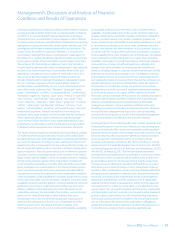Walmart 2013 Annual Report Download - page 29
Download and view the complete annual report
Please find page 29 of the 2013 Walmart annual report below. You can navigate through the pages in the report by either clicking on the pages listed below, or by using the keyword search tool below to find specific information within the annual report.
Management’s Discussion and Analysis of Financial
Condition and Results of Operations
Walmart 2013 Annual Report || 27
Capital Resources
Management believes cash ows from continuing operations and
proceeds from the issuance of short-term borrowings will be su cient to
nance seasonal buildups in merchandise inventories and meet other
cash requirements. If our operating cash ows are not su cient to pay
dividends and to fund our capital expenditures, we anticipate funding
any shortfall in these expenditures with a combination of short-term
borrowings and long-term debt. We plan to re nance existing long-term
debt obligations as they mature and may desire to obtain additional
long-term nancing for other corporate purposes.
Our access to the commercial paper and long-term debt markets has
historically provided us with adequate sources of liquidity. We anticipate
no di culty in obtaining nancing from those markets in the future due
to our favorable experiences in the debt markets in the recent past. Our
ability to continue to access the commercial paper and long-term debt
markets with favorable interest rates and other terms will depend, to a
signi cant degree, on the ratings assigned by the credit rating agencies
to our indebtedness continuing to be at or above the level of our current
ratings. At January 31, 2013, the ratings assigned to our commercial paper
and rated series of our outstanding long-term debt were as follows:
Rating agency Commercial paper Long-term debt
Standard & Poor’s A-1+ AA
Moody’s Investors Service P-1 Aa2
Fitch Ratings F1+ AA
In the event that the ratings of our commercial paper or any rated series
of our outstanding long-term debt issues were lowered or withdrawn for
any reason or if the ratings assigned to any new issue of our long-term
debt securities were lower than those noted above, our ability to access
the debt markets would be adversely a ected. In addition, in such a case,
our cost of funds for new issues of commercial paper and long-term debt
(i.e., the rate of interest on any such indebtedness) would be higher than
our cost of funds had the ratings of those new issues been at or above
the level of the ratings noted above. The rating agency ratings are not
recommendations to buy, sell or hold our commercial paper or debt
securities. Each rating may be subject to revision or withdrawal at any
time by the assigning rating organization and should be evaluated
independently of any other rating. Moreover, each credit rating is
speci c to the security to which it applies.
To monitor our credit rating and our capacity for long-term nancing,
we consider various qualitative and quantitative factors. We monitor the
ratio of our debt-to-total capitalization as support for our long-term
nancing decisions. At January 31, 2013 and 2012, the ratio of our debt-
to-total capitalization was 41.5% and 42.8%, respectively. For the purpose
of this calculation, debt is de ned as the sum of short-term borrowings,
long-term debt due within one year, obligations under capital leases
due within one year, long-term debt and long-term obligations under
capital leases. Total capitalization is de ned as debt plus total Walmart
shareholders’ equity. The decrease in our debt-to-capital ratio resulted
from our growth in retained earnings; although we returned $13.0 billion
to shareholders in the form of dividends and share repurchases, our
retained earnings grew $4.3 billion in scal 2013, primarily due to a
$17.0 billion increase in consolidated net income attributable to Walmart.
Contractual Obligations and Other Commercial Commitments
The following table sets forth certain information concerning our obligations and commitments to make contractual future payments, such as debt
and lease agreements, and certain contingent commitments:
Payments Due During Fiscal Years Ending January 31,
(Amounts in millions) Total 2014 2015–2016 2017–2018 Thereafter
Recorded contractual obligations:
Long-term debt
(1)
$ 43,981 $ 5,587 $ 8,315 $2,255 $27,824
Short-term borrowings 6,805 6,805 — — —
Capital lease obligations
(2)
6,268 620 1,119 939 3,590
Unrecorded contractual obligations:
Non-cancelable operating leases 16,803 1,722 3,078 2,630 9,373
Estimated interest on long-term debt 31,632 1,853 3,382 3,107 23,290
Trade letters of credit 2,726 2,726 — — —
Purchase obligations 4,458 3,394 1,010 50 4
Total commercial commitments $112,673 $22,707 $16,904 $8,981 $64,081
(1) “Long-term debt” includes certain derivative fair value adjustments.
(2) “Capital lease obligations” includes executory costs and imputed interest related to capital lease obligations that are not yet recorded. Refer to Note 11 for more information.
Additionally, the Company has approximately $16.3 billion in undrawn lines of credit and standby letters of credit which, if drawn upon, would be
included in the liabilities section of the Company’s Consolidated Balance Sheets.
Estimated interest payments are based on our principal amounts and expected maturities of all debt outstanding at January 31, 2013, and
management’s forecasted market rates for our variable rate debt.
























